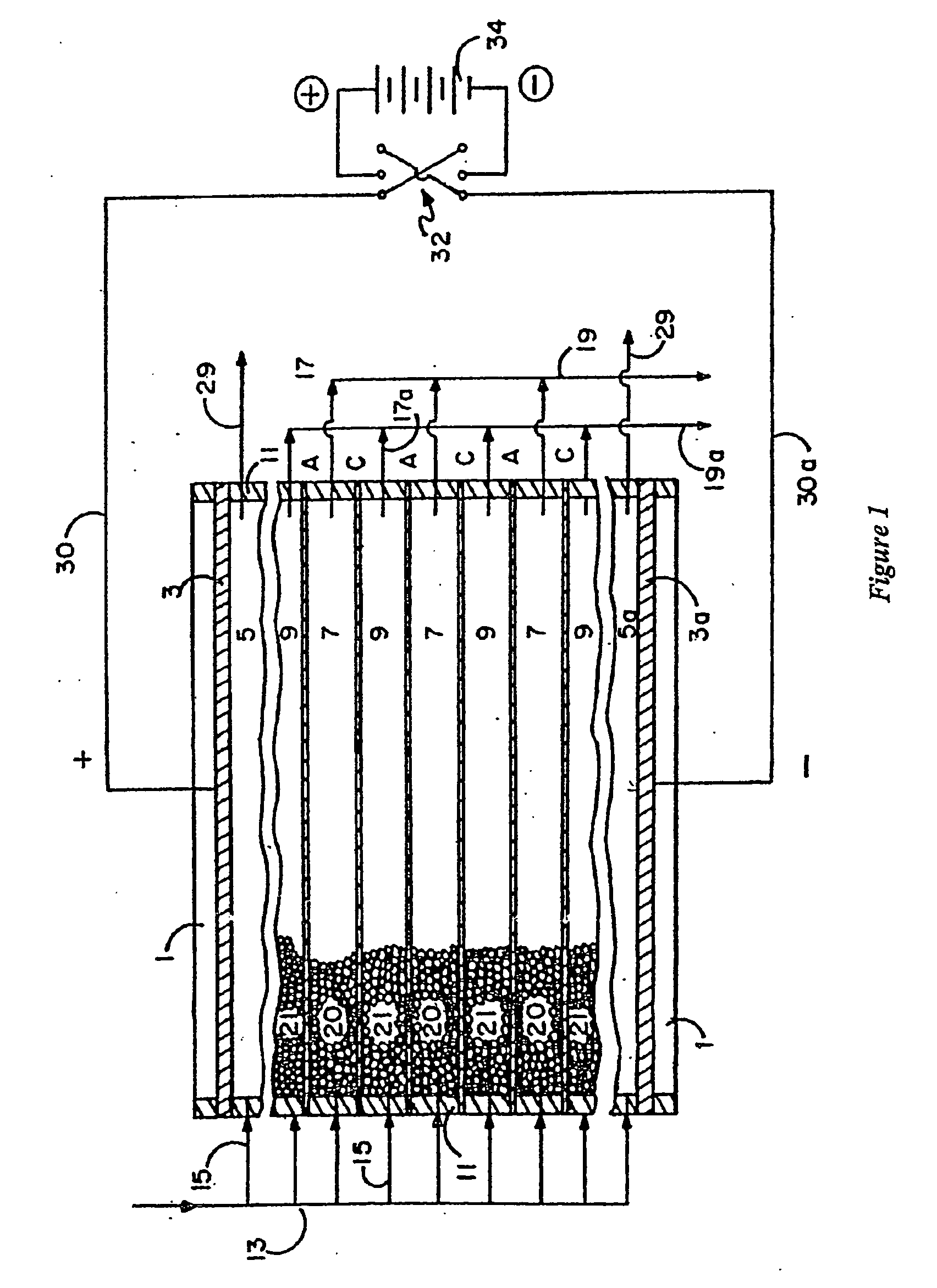Sparse media edi apparatus and method
a technology of edi and media, applied in the field of electrodialysis, can solve the problems of inefficiency of operation, difficulty in uniform filling of thin cells, and inability to meet the needs of patients, and achieve the effects of enhancing fluid shear effect, ensuring stability, and good membrane conta
- Summary
- Abstract
- Description
- Claims
- Application Information
AI Technical Summary
Benefits of technology
Problems solved by technology
Method used
Image
Examples
example 1
[0089] Two IONICS 4″×20″ EDI stacks of eight cell pairs were assembled. One had conventional 120-mil thick dilute cell spacers and the other had dilute cell spacers thirty mils (0.75 mm) thick, effective to define a bi-layer dilute chamber. Layers of beads were distributed and fixed onto the membanes in the central region of the 30 mil spacers by sieving onto a wetted membrane that was covered with a nine strand per inch screen. The screen maintained the deposited beads in position. Both stacks employed the manufacturer's customary anion exchange and cation exchange membranes, and the customary anion exchange and cation exchange resin beads. The two stacks were both tested at a flow rate 0.32 GPM, with a feed water having conductivity of 23 μm / cm and silica loading of 650-695 ppb.
[0090] Table 1 shows the test results. The sparse bead EDI device performance is characterized by higher product resistance, better silica rejection and lower overall stack electrical resistance. The diffe...
example 2
[0091] The surface specific resistance (in Ohms * sq. cm) of one EDI cell having a conventional cation exchange membrane was measured in two series of experiments. In the first series of experiments a conventional screen spacer #3792 (Naltex R) was used with no resin filling. In another series of experiments the same screen was covered by 60 mg / sq. cm of cation exchange resin 650C which was UPW fixed on the screen with Glycerol. A probe current range of 1-5 mA / sq. cm DC was used to carry out surface specific resistance measurements with Na2SO4 test solution having conductivities between 200 and 600 μSm*cm. Cell thickness was 1.60 mm. Results are shown in Table 2.
TABLE 2EDI cell surface specific resistance (Ohm * sq. cm)Na2SO4Cell without cationCell with cationsolution conduct.exchange resin,exchange resin,μSm * cmOhm * sq. cmOhm * sq. cm2001500110400118084600102583
[0092] The data in the Table show that distributing 60 mg / sq. cm of cation exchange resin 650C-UPW in the spacer fixed...
example 3
[0093] A three cell 4″×20″ sparsely filled cell EDI stack (active area 170 sq. cm) with two electrode cells and one dilute cell was built using customary anion exchange and cation exchange membranes of Ionics, Incorporated EDI constructions. The dilute cell was formed with a screen spacer unit formed of 20 mil PE or EVA film melt bonded with a #4610-Naltex R (20 mil) screen. Then, one side of the screen was covered by 4.7 g of dry Dowex Monosphere 550A UPW (OH) anion exchange beads and the other was covered by 0.85 g of a mixture of Dowex Monosphere 650C UPW (H): Dowex Monosphere 500C NG (H)=1:1. The dilute cell contained 85% of 550A UPW (OH), 7.5% of 650C UPW (H) and 7.5% of 500C NG (H). All IX resins were fixed on the spacer by Glycerin. Each electrode cell had a Ti / Pt electrode and was formed by one 4×20 inch regular IONICS EDI electrode spacer (net #3957C, thickness −0.70 mm) covered by 3.00 g of dry 650C UPW fixed by Glycerin.
[0094] The current was 1010 mA, inlet water specifi...
PUM
| Property | Measurement | Unit |
|---|---|---|
| thick | aaaaa | aaaaa |
| mean diameter | aaaaa | aaaaa |
| mean diameter | aaaaa | aaaaa |
Abstract
Description
Claims
Application Information
 Login to View More
Login to View More - R&D
- Intellectual Property
- Life Sciences
- Materials
- Tech Scout
- Unparalleled Data Quality
- Higher Quality Content
- 60% Fewer Hallucinations
Browse by: Latest US Patents, China's latest patents, Technical Efficacy Thesaurus, Application Domain, Technology Topic, Popular Technical Reports.
© 2025 PatSnap. All rights reserved.Legal|Privacy policy|Modern Slavery Act Transparency Statement|Sitemap|About US| Contact US: help@patsnap.com



